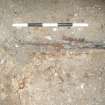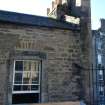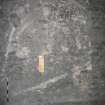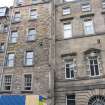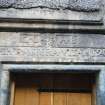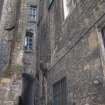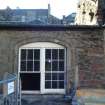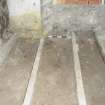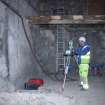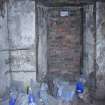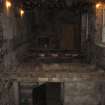Edinburgh, 343 - 355 High Street
Tenement (18th Century)
Site Name Edinburgh, 343 - 355 High Street
Classification Tenement (18th Century)
Alternative Name(s) Advocate's Close; Roxburgh's Close
Canmore ID 52299
Site Number NT27SE 278
NGR NT 25707 73625
Datum OSGB36 - NGR
Permalink http://canmore.org.uk/site/52299
- Council Edinburgh, City Of
- Parish Edinburgh (Edinburgh, City Of)
- Former Region Lothian
- Former District City Of Edinburgh
- Former County Midlothian
NT27SE 278 25707 73625
The 6-storeyed tenement at the top of Advocate's Close dates from the 18th century, incorporating earlier work. Doorways on the E side of the Close bear the initials of Clement Cor and his wife Helen Bellenden, and date 1590, with the motto BLISSIT. BE.GOD.OF.AL.HIS.GIFTIS and SPES.ALTERA.VITAE. 17th-century circular stair tower at rear.
RCAHMS 1951.
Publication Account (1951)
21. Advocate's Close, 357 High Street.
Although there has been a considerable clearance here, this close remains one of the most picturesque in Edinburgh. The tall tenement at the top, which occupies the site formerly owned by Andrew Barthrame (see Historical Note), dates only from the 18th century, and its flats have panelling and fireplaces characteristic of that period. But it includes an older element of which the turnpike on the W. side of the close seems to be substantially apart, as the doorway at the stair foot has a little cornice of 17th-century type. Another doorway immediately to the N. is identical but is an obvious addition to the fragmentary structure behind, which must be dated somewhat earlier in the same century. Again, on the E. side there are two other doorways, also side by side beneath an encorbellment, the lintel of the more northerly one bearing a shield charged: Quarterly, 1st and 4th, a heart; 2nd and 3rd, a rose, and flanked by the initials of Clement Cor and his wife Helen Bellenden (see Historical Note). Below runs the motto SPES ALTERA VITAE (“Another hope of life") 1590. The adjoining lintel also has a shield which bears a merchant's mark and is flanked by the initials C C and the date 1590, the motto below reading BLISSIT BE GOD OF AL HIS GIFTS. The building above has been redressed. The extension on the N., apparently built by Nicol Edgar at some time between 1610 and 1620, has four storeys, of which the lowest three are not later than the 17th century, while the top floor is comparatively modern. The lower openings are chamfered; two windows on the second floor are delicately moulded and the S. one was originally transomed. Some carved stones removed from elsewhere have been let into the modern building farther N. These include a large panel, uncarved but with scalloped edges, which came from Warriston's Close, and five skew-puts of unknown provenance. One seems to bear the initial W, another has a merchant's mark, while three more exhibit coats of arms, respectively: (a) On a chevron between two slips in chief and an illegible charge in base, an illegible charge. This coat may be intended either for Riddell (a chevron between three ears of rye) or for Russell (a chevron between three tadpoles). (b) On a chief three mullets, with the initials D N separated by a heart below. (c) A saltire and chief, for Bruce.
HISTORICAL NOTE.
At one time this alley was known as Cant's Close, and then as Clement Cor's Close (1) until Sir James Stewart of Coltness, Lord Provost in 1648-9 and in 1658-9, went to reside in a house at the foot of the W. side. It was then called Stewart's Close or Provost Stewart's Close after him. The house was inherited and rebuilt by the Lord Provost's son, Sir James Stewart of Goodtrees, and as this Sir James held office as Lord Advocate from 1692 to 1713 the Close was thereafter re-named Advocate's Close.
There is every reason to suppose that the Close suffered in Hertford's raid of 1544. In 1562, at all events, Symon Johnestoun granted John Murdo, shoemaker and burgess of Edinburgh, a charter of his waste and burnt land (meam terram nunc vastamet combustam) lying within the tenement of land of the late Henry Cant on the E. part of the transe of the same. In 1579 John Murdo in his turn granted a charter to Clement Cor of Reidwalls conveying the waste lands of the late Andrew Murdo on the E. side of Cant's Close. Since 1566 Cor had been a burgess and guild brother of Edinburgh. He became Dean of Guild in 1588, and bailie between 1589 and 1595. By his wife Helen Bellenden he had four daughters, Margaret, Isobel, Bessie and Janet. Towards the close of the century he seems to have retired to St. Andrews, and when he died in 1608 he was buried in the cathedral churchyard there. (2) In 1590 Cor built his house upon the S. half of his property in Cant's Close, the property of the late Andrew Barthrame separating it from the street. So far as can be ascertained, the building seems to have been of either four or five storeys, with a separate house upon every floor except the lowest one which was first used as a stable and latterly divided into two cellars. The residential portion was approached by a forestair, whence the ascent was continued by a turnpike at each end of the building. The accommodation upon the first floor included a hall, a study, two chambers, a kitchen and a cellar.
Cor's daughter, Margaret, married Alexander Levingstoune, advocate, in 1588. Five years before his death her father granted the young couple a charter conveying both the tenement of land then built upon and also the land on its N. side still lying waste. With his wife's consent, Levingstoune sold the three lower floors to Nicoll Edgar, merchant burgess, in 1610, the upper floor or floors remaining apparently in his own possession. The waste land seems to have passed with the rest, since Edgar built upon it within the next ten years. Cf. John K. Laidlaw, The Advocate's Close.
RCAHMS 1951
(1) Annuity Roll of 1634, p. 104. (2) P.S.A.S., lxx(1935-6), pp. 110-113·
Standing Building Recording (1 June 2010 - 1 October 2010)
NT 2570 7363 A standing building survey and watching brief were undertaken 1 June–1 October 2010 prior to and during groundworks associated with redevelopment of the site. The documentary evidence indicated that the complex of buildings between Roxburgh’s Close and Advocate’s Close have been extensively modified during the last 500 years, with major episodes of building, demolition and rebuilding. Originally high status homes and work places for merchants and tradesmen, the condition of buildings in this part of Edinburgh declined, particularly after the building of the New Town. It is likely that some properties were used for industrial purposes and by the 1860s parts were described as slums, and were subsequently demolished and rebuilt.
The work undertaken established a preliminary phasing for some elements of the buildings. The basement rooms along the High Street could potentially be of 15th-century date, but the buildings along Advocate’s Close contained substantial 16th- and 17th-century elements. It is probable that the rooms of the N Flat (Rooms F2 and F3) are substantially of this date and are part of what was once a much higher tenement with jettied overhangs and painted ceilings. The current High Street frontage has been significantly modified
and the building was severely truncated in the 1930s, when the extension to the City Chambers was constructed. Much of the surviving masonry fabric is probably 18th century. To the rear (N) of the property, fronting Roxburgh’s Close, the rooms forming the current sub-basement, basement and ground floors are comparatively recent, probably dating to the late 18th or 19th century, and appear to abut the older building to the W.
Archive: RCAHMS
Funder: Mark and Sylvia Hamilton
Tim Holden – Headland Archaeology Ltd





































